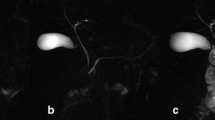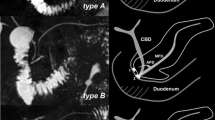Abstract
Objectives
To evaluate secretin-enhanced MRCP (S-MRCP) findings of patients with pancreas divisum and Santorinicele, before and after minor papilla sphincterotomy.
Methods
S-MRCP examinations of 519 patients with suspected pancreatic disease were included. Size of the main pancreatic duct, presence and calibre of Santorinicele were evaluated. Duodenal filling was assessed on dynamic images. After sphincterotomy the same parameters and the clinical findings were re-evaluated.
Results
Pancreas divisum was depicted in 55/519 patients (11 %) by MRCP and an additional 26/519 by S-MRCP (total 81/519, 16 %). Santorinicele was detected in 7/81 patients (8.6 %) with pancreas divisum by MRCP and an additional 20/81 by S-MRCP (total 27/81, 33 %). Dorsal duct in patients with Santorinicele was significantly larger in the head compared with patients with only pancreas divisum (p < 0.01), in basal conditions (average 2.4 versus 1.9 mm) and after secretin administration (average 3.0 versus 2.4 mm). Duodenal filling was impaired in 11/27 patients (41 %) with Santorinicele. After sphincterotomy significant reduction in size of Santorinicele (−33 %) and dorsal duct (−17 %), increase of pancreatic juice and symptoms improvement were observed.
Conclusion
Secretin administration increases the accuracy of MRCP in detecting Santorinicele and demonstrates the impaired duodenal filling. S-MRCP is useful to assess results of sphincterotomy.
Key Points
• Secretin-enhanced MRCP gives anatomical and functional information on pancreatic outflow dynamics.
• Santorinicele is a cystic dilatation of the termination of the Santorini duct.
• S-MRCP images are the most useful to recognize the presence of Santorinicele.
• Minor papilla sphincterotomy during ERCP is indicated in patients with Santorinicele.




Similar content being viewed by others
References
Manfredi R, Brizi MG, Tancioni V, Vecchioli A, Marano P (2001) Magnetic resonance pancreatography (MRP): morphology and function. Rays 26:127–133
Manfredi R, Brizi MG, Costamagna G, Masselli G, Vecchioli Scaldazza A, Marano P (2002) Pancreas divisum and Santorinicele: assessment by dynamic magnetic resonance cholangiopancreatography during secretin stimulation. Radiol Med 103:55–64
Liao Z, Gao R, Wang W et al (2009) A systematic review on endoscopic detection rate, endotherapy, and surgery for pancreas divisum. Endoscopy 41:439–444
Lerner A, Branski D, Lebenthal E (1996) Pancreatic diseases in children. Pediatr Clin North Am 43:125–156
Gonoi W, Akai H, Hagiwara K et al (2011) Pancreas divisum as a predisposing factor for chronic and recurrent idiopathic pancreatitis: initial in vivo survey. Gut 60:1103–1108
Stern CD (1986) A historical perspective on the discovery of the accessory duct of the pancreas, the ampulla 'of Vater' and pancreas divisum. Gut 27:203–212
Griffin N, Charles-Edwards G, Grant LA (2012) Magnetic resonance cholangiopancreatography: the ABC of MRCP. Insights Imaging 3:11–21
Cotton PB (1980) Congenital anomaly of pancreas divisum as cause of obstructive pain and pancreatitis. Gut 21:105–114
Gregg JA (1977) Pancreas divisum: its association with pancreatitis. Am J Surg 134:539–543
Eisen G, Schutz S, Metzler D, Baillie J, Cotton PB (1994) Santorinicele: new evidence for obstruction in pancreas divisum. Gastrointest Endosc 40:73–76
Seibert DG, Matulis SR (1995) Santorinicele as a cause of chronic pancreatic pain. Am J Gastroenterol 90:121–123
Bret PM, Reinhold C, Taourel P, Guibaud L, Atri M, Barkun AN (1996) Pancreas divisum: evaluation with MR cholangiopancreatography. Radiology 199:99–103
Matos C, Metens T, Deviere J et al (1997) Pancreatic duct: morphologic and functional evaluation with dynamic MR pancreatography after secretin stimulation. Radiology 203:435–441
Manfredi R, Costamagna G, Vecchioli A, Colagrande C, Spina S, Marano P (1998) Dynamic pancreatography with magnetic resonance after functional stimulus with secretin in chronic pancreatitis. Radiol Med 96:226–231
Nicaise N, Pellet O, Metens T et al (1998) Magnetic resonance cholangiopancreatography: interest of IV secretin administration in the evaluation of pancreatic ducts. Eur Radiol 8:16–22
Manfredi R, Costamagna G, Brizi MG et al (2000) Pancreas divisum and "Santorinicele": diagnosis with dynamic MR cholangiopancreatography with secretin stimulation. Radiology 217:403–408
Costamagna G, Ingrosso M, Tringali A, Mutignani M, Manfredi R (2000) Santorinicele and recurrent acute pancreatitis in pancreas divisum: diagnosis with dynamic secretin-stimulated magnetic resonance pancreatography and endoscopic treatment. Gastrointest Endosc 52:262–267
Lutzak GD, Gluck M, Ross AS, Kozarek RA (2013) Endoscopic minor papilla sphincterotomy in patients with Santoriniceles reduces pain and improves quality of life. Dig Dis Sci 58:2075–2081
Frulloni L, Falconi M, Gabbrielli A et al (2010) Italian consensus guidelines for chronic pancreatitis. Dig Liver Dis 42(Suppl 6):S381–S406
Quest L, Lombard M (2000) Pancreas divisum: opinio divisa. Gut 47:317–319
Spicak J, Poulova P, Plucnarova J, Rehor M, Filipova H, Hucl T (2007) Pancreas divisum does not modify the natural course of chronic pancreatitis. J Gastroenterol 42:135–139
Kamisawa T, Yuyang T, Egawa N, Ishiwata J, Okamoto A (1998) Patency of the accessory pancreatic duct in relation to its course and shape: a dye-injection endoscopic retrograde pancreatography study. Am J Gastroenterol 93:2135–2140
Rosch W, Koch H, Schaffner O, Demling L (1976) The clinical significance of the pancreas divisum. Gastrointest Endosc 22:206–207
Benage D, McHenry R, Hawes RH, O'Connor KW, Lehman GA (1990) Minor papilla cannulation and dorsal ductography in pancreas divisum. Gastrointest Endosc 36:553–557
Delhaye M, Engelholm L, Cremer M (1985) Pancreas divisum: congenital anatomic variant or anomaly? Contribution of endoscopic retrograde dorsal pancreatography. Gastroenterology 89:951–958
DiMagno MJ, Wamsteker EJ (2011) Pancreas divisum. Curr Gastroenterol Rep 13:150–156
Fukukura Y, Fujiyoshi F, Sasaki M, Nakajo M (2002) Pancreatic duct: morphologic evaluation with MR cholangiopancreatography after secretin stimulation. Radiology 222:674–680
Gonoi W, Akai H, Hagiwara K et al (2013) Santorinicele without pancreas divisum pathophysiology: initial clinical and radiographic investigations. BMC Gastroenterol 13:62
Acknowledgments
The scientific guarantor of this publication is Roberto Pozzi Mucelli. The authors of this manuscript declare no relationships with any companies whose products or services may be related to the subject matter of the article. The authors state that this work has not received any funding. The authors consulted a colleague (William Mantovani, MD, Department of Statistic, Policlinico G.B. Rossi, Verona) with significant statistical expertise. Institutional review board approval was obtained. Written informed consent was waived by the institutional review board. Methodology: retrospective, observational, performed at one institution.
Author information
Authors and Affiliations
Corresponding author
Rights and permissions
About this article
Cite this article
Boninsegna, E., Manfredi, R., Ventriglia, A. et al. Santorinicele: secretin-enhanced magnetic resonance cholangiopancreatography findings before and after minor papilla sphincterotomy. Eur Radiol 25, 2437–2444 (2015). https://doi.org/10.1007/s00330-015-3644-0
Received:
Revised:
Accepted:
Published:
Issue Date:
DOI: https://doi.org/10.1007/s00330-015-3644-0




